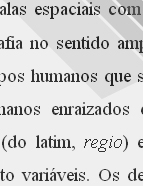

................................
Bibliografia:
Repertórios
ARANHA, P.W. Brito - Bibliographie des ouvrages portugais, pour servir a l'étude des villes, des villages, des monuments, des institutions, des moeura et coutumes, etc., du Portugal, Acores, Madère et possessions d'outremer . Lisbonne: Imprimerie Nationale, 1900; CANTO, Ernesto do - Bibliotheca Açoriana: noticia bibliographica das obras impressas e manuscriptas nacionaes e estrangeiras, concernentes às ilhas dos Açores , Ponta Delgada: s.n., 1890-1900; DIAS, Eduardo da Rocha - Monographias e outras obras referentes a varias localidades e monumentos do continente de Portugal: breve indicação . Lisboa: Casa da Moeda, 1908; FIGUEIREDO, A. Mesquita de - Subsídios para a bibliografia da história Local portuguesa . Lisboa: Biblioteca Nacional, 1933; LAUTENSACH, Hermann (prep.); FEIO, Mariano (adaptação e complemento) – Bibliografia geográfica de Portugal . Lisboa: Centro Est. Geográficos. Instituto para a Alta Cultura, 1948-1982, 2 vol.; LIMA, Durval Pires de – Bibliografia corográfica de Portugal . (A-L e M-V), 2 tomos. Lisboa: Biblioteca Popular de Lisboa, 1962-1964 e 2 suplementos (A-J e L-V), Lisboa: Biblioteca Popular de Lisboa, 1968-69; LOUREIRO, José Pinto – Bibliografia Coimbrã . Coimbra: Câmara Municipal 1964; PEREIRA, Benjamim Enes – Bibliografia analítica de etnografia . Lisboa: Instituto de Alta Cultura, Centro de Estudos de Etnologia Peninsular, 1965; Repertório Bibliográfico da Historiografia Portuguesa (1974-1994) . Coimbra: Fac. de Letras de Coimbra, 1995.
Metodologias, problemas e análises críticas
ALARCÂO, Jorge de - Introdução ao estudo da história e do património locais . Coimbra: Instituto de Arqueologia, Fac. de Letras, 1988; ALVAREZ JUNCO, Jose “Las historias de España”, in História de Espana , dir. J. Fontana e R. Villares, Madrid, M. Pons, 2013; BRAGA, Isabel M. R. Mendes Drummond – “Poder local e historiografia universitária sobre temáticas regionais (1974-2000)”. In O poder local em tempo de globalização uma história e um futuro . Fernando Taveira (coord.). Viseu: Palimage, 2005, p. 171- 192; CAETANO, Marcello. Monografias sobre os concelhos portugueses . Lisboa: Universidade de Lisboa, Faculdade de Direito, 1935; CAPELA, José Viriato – “História municipal, história local e história nacional. Notas para um projecto de estudo”. In Estudos de homenagem a Joaquim Veríssimo Serrão . Lisboa: Edições Colibri, 1995, p. 721-729; COELHO, Maria Helena da Cruz, “Balanço sobre a história rural produzida em Portugal nas últimas décadas”. In a Cidade e o Campo. Colectânea de Estudos . Coimbra: Centro de História da Sociedade e da Cultura, 2000, p. 23-40; COELHO, P. M. Laranjo – Monografias Locais na Literatura Histórica Portuguesa . Lisboa: Academia das Ciências de Lisboa, 1935; COELHO, P. M. Laranjo – Vantagens do estudo das monografias locais para o conhecimento da história geral portuguesa . Coimbra: Imprensa da Universidade, 1926; ESTÊVÃO, João Nunes, “Reconstituição histórica de comunidades locais (séc. XVII-XX)”. In 2º Congresso Histórico de Guimarães, Actas, vol.7, Guimarães: Câmara Municipal, 1996, p. 470-571; FERNÁNDEZ PRIETO, L. – “Historia local, nacional e transnacional”. In Maia. História Regional e local . I. Actas do Congresso. Maia: Câmara Municipal da Maia, 1999; JOÃO, Maria Isabel – “Região, Nação e Historiografia Local: O caso dos Açores”. Historiografia e memórias (Séculos XIX e XXI) . Sérgio Campos Matos e Maria Isabel João (orgs.). Lisboa: Centro de História da FLUL/CEMRI da UAb, 2012; MACEDO, Jorge Borges de – “Unidade e diversidade de situação nas áreas regionais em Portugal. Consequências metodológicas”. Primeiras Jornadas de História Regional e Local . Lisboa: Colibri, 1993, p. 11-33; MARQUES, Oliveira A. H. de – Ensaios de historiografia portuguesa . Lisboa: Palas Editores Lda., 1988; MATOS, Álvaro e RASGA, Raul (coord.). Primeiras jornadas de história local e regional. Lisboa: Colibri, 1993; MATOS, Sérgio Campos – “História nacional e história local no Portugal oitocentista”. In Turres Veteras III. Actas de História Contemporânea . S.L: Câmara Municipal de Torres Vedras, [2001]; MENDES, J. Amado – “História local e memórias: do Estado-Nação à globalização”. Revista Portuguesa de História . T. XXXIV, 2000, p. 349-368; NETO, Margarida Sobral - “Percursos da história local portuguesa”. In Memória e História Local . Colóquio Internacional realizado em Idanha-a-Nova, João Marinho dos Santos e António Silveira Catana (coord.).
This work is financed by national funds through FCT - Foundation for Science and Technology, I.P, in the scope of the projects UIDB/04311/2020 and UIDP/04311/2020.
